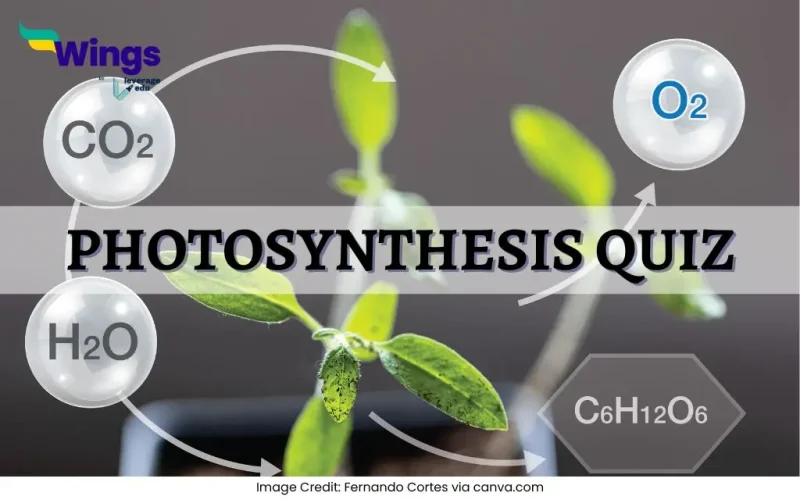Are you ready to test your knowledge of one of the most important processes in nature? Attempt these photosynthesis quiz questions and answers to see how much you really know! Ever wondered what is photosynthesis? It is a process through which plants make their food using sunlight, carbon dioxide, and water. It’s crucial for life on Earth as it provides oxygen for all living creatures. Whether you are preparing for a test on photosynthesis or studying for an upcoming biology exam, these photosynthesis quiz questions and answers can help you prepare accordingly. So grab your thinking cap—let’s dive in and see how many you can ace!
Photosynthesis Quiz Questions and Answers for Class 8, 9, and 10

In this section, you will find 25 quiz questions and answers for a quiz test on photosynthesis. Make sure to read each question carefully and choose the most accurate answer. Once you are done attempting all the questions, use the Answer Key at the end to see how many you got right. Keeping these instructions in mind, let’s begin photosynthesis MCQs.
1. What is the main function of photosynthesis in green plants?
A. Convert oxygen into water
B. Convert light energy into chemical energy
C. Convert carbon dioxide into nitrogen
2. What are the main raw materials required for photosynthesis?
A. Nitrogen and oxygen
B. Water, carbon dioxide, and minerals
C. Fossil fuels and chlorophyll
3. What would happen if photosynthesis stopped on Earth?
A. Oxygen levels would increase
B. Most organisms would disappear
C. Earth’s atmosphere would remain unchanged
4. What type of bacteria can survive without photosynthesis?
A. Chemosynthetic bacteria
B. Photosynthetic bacteria
C. Aerobic bacteria
5. What is the relationship between photosynthesis and fossil fuels?
A. Fossil fuels are formed by the remains of photosynthetic plants and organisms
B. Photosynthesis produces fossil fuels directly
C. Fossil fuels are not related to photosynthesis
6. What gas is released as a by-product of photosynthesis?
A. Carbon dioxide
B. Nitrogen
C. Oxygen
7. What is the function of chlorophyll in photosynthesis?
A. It produces glucose
B. It stores energy as a form of starch
C. It captures and transfers energy from sunlight
8. Where does photosynthesis take place in plant cells?
A. Mitochondria
B. Nuclei
C. Chloroplasts
9. What new technology was developed to improve plant productivity after the 1970s?
A. Genetic engineering of plants
B. Solar-powered fertilizers
C. Mechanical crop planting
10. Which animal has the unique ability to produce chlorophyll and harness light energy?
A. Emerald green sea slug
B. Pea aphid
C. Green tree frog
11. What energy-rich compound can the pea aphid produce using light?
A. Chlorophyll
B. ATP (Adenosine triphosphate)
C. Glucose
12. Why has genetic engineering not yet dramatically increased crop yields?
A. It is expensive to implement
B. The traits involved are highly complex
C. Farmers do not use genetically modified seeds
13. Who is credited with beginning the study of photosynthesis in 1771?
A. Jan Ingenhousz
B. Cornelis van Niel
C. Joseph Priestley
14. Identify the primary waste product of photosynthesis.
A. Carbon dioxide
B. Oxygen
C. Hydrogen
15. What is the chemical equation for photosynthesis?
A. 6CO2 + 6H20 + Light – C6H12O6 + 6O2
B. C6H12 + Light + – 6CO2 + 6H2O
C. CO2 + H2O + Light – 6H2O + light
16. Which process stores light energy as chemical energy during photosynthesis?
A. Oxidation-reduction
B. Combustion
C. Respiration
17. What are the major organic products of photosynthesis in green cells?
A. Lipids and proteins
B. Carbohydrates such as starch and sucrose
C. Amino acids and nucleotides
18. What are the two stages of photosynthesis?
A. Combustion and synthesis
B. Light and dark stages
C. Oxidation and reduction
19. What is the main purpose of the light stage of photosynthesis?
A. To absorb carbon dioxide from the atmosphere
B. To synthesize ATP and NADPH
C. To break down carbohydrates
20. During the dark stage, what is carbon dioxide reduced to?
A. Water
B. Nitrogen compounds
C. Organic carbon compounds
21. What did Cornelis van Niel discover about photosynthesis in sulfur bacteria?
A. Oxygen is released from water
B. Sulfur is produced instead of oxygen
C. Light energy is not required for photosynthesis
22. Why are plants green rather than black in colour?
A. To absorb more sunlight
B. Chlorophyll absorbs solar radiation efficiently
C. The colour helps protect plants from sunlight
23. What minerals are essential for photosynthesis in plants?
A. Nitrogen, potassium, and calcium
B. Magnesium, copper, and chloride
C. Phosphate, sulfur, and zinc
24. What simple carbohydrate is formed during photosynthesis?
A. Fructose
B. Glucose
C. Sucrose
25. What accounts for the storage of light energy as chemical energy in photosynthesis?
A. The breaking and forming of chemical bonds
B. The absorption of sunlight by chloroplasts
C. The production of glucose from carbon dioxide
Answer Key for questions on photosynthesis
| 1. B | 6. C | 11. B | 16. A | 21. B |
| 2. B | 7. C | 12. B | 17. B | 22. B |
| 3. B | 8. C | 13. C | 18. B | 23. A |
| 4. A | 9. A | 14. B | 19. B | 24. B |
| 5. A | 10. A | 15. A | 20. C | 25. A |
Photosynthesis Quiz Questions and Answers PDF
Interesting Reads
Hope you like this photosynthesis quiz questions and answers. If you want to try more fun quizzes similar to these questions on photosynthesis, make sure to check out the Quiz category by Leverage Edu.

 One app for all your study abroad needs
One app for all your study abroad needs






















 45,000+ students trusted us with their dreams. Take the first step today!
45,000+ students trusted us with their dreams. Take the first step today!


